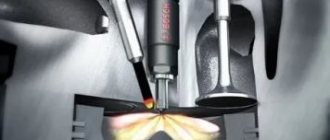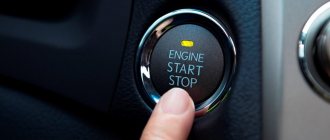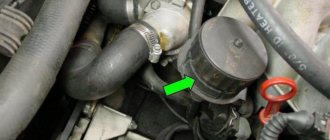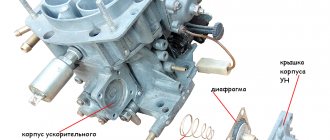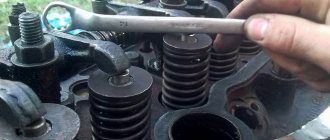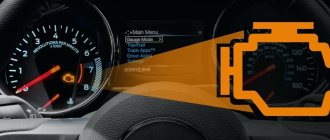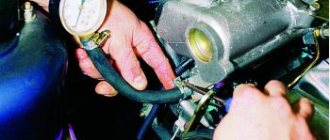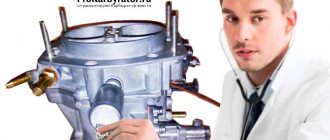Adjusting the fuel injection pump on a test stand
Adjustment of the plunger pairs to the same stroke value and the same amount of feed, as well as adjustment of the speed controller and injection advance device (clutch) are carried out on a special test stand for high-pressure fuel injection pumps. These stands are equipped with all the necessary measuring devices and a variable speed drive. The repair and test instructions on the test stand, together with the necessary data, contain all the necessary information for repair and service work.
Adjusting the fuel injection pump on the engine
The fuel injection pump is synchronized with the engine using timing marks to start injection (closing the channel). These marks are located on the engine and on the fuel injection pump.
Typically, the engine's compression stroke is used as the basis (the reference point for injection timing adjustments, although other possibilities may be used for a particular engine model). In this regard, it is important that the manufacturer's instructions are taken into account. In most cases, the timing mark for closing the channel is located on the engine flywheel, on the V-belt pulley or on the vibration damper. There are several possibilities for adjusting the injection pump and setting the correct value for the start of injection (closing the channel).
- The fuel injection pump is delivered from the factory in a form where its cam shaft is locked in a predetermined position. After installing the injection pump on the engine and strengthening it with bolts, when the crankshaft is in the appropriate position, the cam shaft of the injection pump is released. This well-tested method is inexpensive and is becoming more and more popular.
- The injection pump is equipped with a channel closing indicator at the end of the regulator, which must be aligned with the installation marks when the injection pump is installed on the engine.
- The injection timing advance device (clutch) has a mark for closing the hole, which must be aligned with the mark on the injection pump body. This method is not as accurate as the two described earlier.
- After the fuel injection pump is installed on the engine, a high pressure flow method is used at one of the pump outlets to determine the point (moment) of channel closure (i.e., when the plunger closes the fuel outlet channel). This "wet" method is also being actively replaced by method 1 and 2 described earlier.
Adjusting the injection pump
Adjusting the high pressure fuel pump (HPF) is one of the most important components of the entire fuel system in cars with a diesel engine. The main function of the injection pump is to supply fuel with a certain set pressure to the injectors. The pump’s tasks also include determining the amount of diesel supplied and limiting the supply using a special valve. Correct adjustment of the fuel injection pump allows you to optimize the operation of the engine as a whole, as well as significantly save on fuel consumption. Using the high-pressure fuel pump, you can also control idle speed, which is especially important in low temperatures outside and when additional equipment is turned on: air conditioning or refrigerator.
How to regulate fuel injection pump
Adjusting the injection pump high pressure fuel pump (HPFP)
There are two ways to adjust: yourself or in a professional auto repair shop. In the second case, debugging of the unit is carried out using specialized equipment - stands, which private garages and home workshops lack.
There are two types of injection pump adjustment: adjustment of cyclic feed and adjustment of the advance angle of the start of feed. A complete service includes both of these processes.
Before you start adjusting the fuel injection pump, you should remove the metered fuel injection advance clutch. After this, it is necessary to attach a special cam shaft, equipped with its own drive and connected to the stand. Next, the process of fuel supply, its uniformity and volume is analyzed, the moment of supply itself is calculated, to determine which a momentoscope device is used.
To ensure the longest possible service life of the pump and the fuel system as a whole, the injection pump should be adjusted at intervals determined by the manufacturer and recommended oils should be used.
And although the procedure for adjusting the injection pump is quite simple, if necessary, it is better to turn to professionals who have specialized equipment rather than trying to solve the problem yourself and adjusting the injection pump at random.
It is worth noting that neglecting the injection pump adjustment can lead to much more serious consequences than increased speed and increased fuel consumption. If minor faults are not eliminated in time and the injection pump is not adjusted, breakdowns can become serious, which will require replacement of individual system components without the possibility of repair.
You should not start adjusting the fuel injection pump, because this not only ensures driving comfort, but also significant savings in the future. Contact us if you need to adjust the fuel injection pump and want the work to be done really well.
Removing air from the fuel injection system
Rice. Removing air from the fuel injection system
Air bubbles in the fuel can impair the operation of the fuel injection pump or even make it impossible. In this regard, devices that are installed for the first time or are temporarily disconnected must be freed from air.
If the fuel priming pump is equipped with a hand pump, then it is used to fill the line, fuel filter and injection pump with fuel. In this case, the ventilation screws (1) on the filter cover and on the fuel injection pump must remain open until the escaping fuel contains no bubbles. Bleeding must be done every time the fuel filter is replaced or any work is done on the system.
During real-life operation, air is removed from the injection system automatically through the flow valve (2) on the fuel filter (continuous ventilation). A restrictor can be used instead of a valve if the pump does not have a flow valve.
Other methods of bleeding the fuel system of a diesel engine
So, above we looked at the main way to bleed a diesel fuel system.
At the same time, many specialists and experienced car enthusiasts separately point out that in some cases such attempts to bleed the pump can have serious consequences for the power system. Please note that the reason for this concern is that if there is mechanical damage, bleeding in this manner can cause irreparable damage. Let's look at other existing methods
First of all, the bolt on the fuel return line (the so-called “return”) is loosened. Next, you should carefully monitor how the fuel comes out. If air bubbles are visible, then this means that the system is airy.
If so, you can use a simple tire inflator or compressor. Next, the hose is removed from the fuel pump and the air pump hose is installed in its place. The basic idea is that pumping occurs, which allows the pressure in the system to increase. This pressure makes it possible to pump diesel fuel into the fuel pump.
So, first the fuel filter is removed and its housing is dried. Then the individual elements are wiped, then reassembled. Next you will need to locate two fittings on the filter housing. One of the fittings is needed for draining diesel fuel, and the other is suitable for pumping.
Having prepared the vacuum cleaner, you also need a regular medical syringe and a hose 30-40 cm long. For these purposes, it is recommended to use a transparent type of hose. The syringe is inserted into the hose, and the other end of the hose is put on the bleeder fitting.
Next, the piston is pulled out of the syringe, and the vacuum cleaner tube is inserted into the syringe. The main thing is to achieve reliable fixation and a tight fit. Also, the joints can be sealed by putting on pieces of hoses of different diameters, winding electrical tape, etc.
Now you can unscrew the fitting a little, after which the vacuum cleaner turns on. After a few seconds, yellowish foam can be seen in the syringe. This is a mixture of diesel fuel and air. Further pumping comes down to ensuring that the syringe is filled with clean diesel fuel instead of foam.
Let's consider another solution that allows, in some cases, to quickly pump the diesel fuel system. To do this, it is enough to completely fill the fuel filter housing with diesel fuel, after which the engine starts. Next, you need to let the engine run at high speeds, as a result of which the power system is pumped.
Injection pump lubrication
It is best to connect the injection pump and regulator to the engine lubrication system, because With this form of lubrication, the injection pump remains maintenance-free. Filtered engine oil is supplied to the injection pump and regulator through the discharge line and the inlet channel through the roller tappet hole or using a special oil supply valve. In the case of a base or frame fuel injection pump, the lubricating oil is returned to the engine via the return line (b).
In the case of flange mounting, the return of lubricating oil can occur through the camshaft bearing(s) or through special channels. Before turning on the injection pump and regulator for the first time, they must be filled with the same oil as the engine. In the case of an injection pump without a direct connection to the engine oil system, oil is poured in through the cover after removing the air bleeder cap or filter. The oil level in the pump is checked by removing the oil level screw on the regulator at the intervals prescribed by the engine manufacturer for changing the engine oil. Excess oil (an increase in the amount due to oil leakage from the lubrication system) must be drained, and if there is not enough oil, then add fresh oil. When the injection pump is removed or when the engine undergoes major repairs, the lubricating oil must be replaced. To check the oil level, injection pumps and regulators with a separate oil supply are equipped with their own dipstick.
Disabling the injection pump for a long time
If the engine and, accordingly, the injection pump remain unmaintained for a long time, then no diesel fuel should remain in the injection pump, because Over time, it becomes thick and viscous, plungers and discharge valves can seize and even corrode. For this reason, before preservation, it is necessary to add approximately 10% of a suitable anti-rust agent to the fuel tank and in the same proportion to the oil in the injection pump camshaft chamber. The engine should then be started for approximately 15 minutes, during which all normal diesel fuel will be flushed out of the injection pump, which at the same time will be effectively protected from fuel thickening and corrosion. New injection pumps, which have already been effectively protected from corrosion at the factory, are marked with the letter “r”.
Assembly of diesel engine fuel equipment.
The fuel equipment of internal combustion engines includes components and mechanisms that ensure cleaning and supply of fuel to the cylinders in an amount corresponding to the engine load at a given speed. For carburetor engines, fuel equipment includes booster pumps, filters and carburetors; for diesel engines - booster pumps, filters, fuel pumps, injectors and pipelines.
The assembly of diesel fuel equipment is described below. For normal atomization, fuel is supplied to the nozzles at high pressure, reaching 800-1000 kg/cm2 in some diesel designs, which creates special requirements for the tightness of high-pressure pipeline connections. Small gaps in the mating of such important components as plunger pairs and nozzles, as well as small cross-sections of the atomizing holes require fine cleaning of the fuel, since even small solid particles in the fuel can cause jamming of parts and clogging of the holes.
To ensure uniform loading of all cylinders of multi-cylinder engines, a uniform supply of fuel to all injectors is required both at maximum and at partial loads. To meet these requirements for fuel equipment, it is necessary to carefully perform all assembly operations, maintain the gaps specified in the drawing, and avoid jamming in moving joints. In addition, assembly areas and work areas should be kept clean.
Maintenance, repair and diagnostics of the high pressure fuel pump (HPF)
This article will help you understand the nuances of diagnosing injection pump. He will talk about the importance of timely diagnosis of this complex system.
The high pressure fuel pump - high pressure fuel pump - is one of the most complex components in the fuel supply system of a diesel engine. Let's consider the features of its maintenance, diagnostics and repair.
This article will help you understand the nuances of diagnosing injection pump . He will talk about the importance of timely diagnosis of this complex system. You will learn some important features of ensuring the smooth operation of the injection pump. Study the list of works on computer diagnostics and adjustment of the functioning of the mechanism.
Timely adjustment of the injection pump - conditions for its uninterrupted operation
Information about the repair work provided for setting up high-pressure fuel pumps will help ensure the need to entrust the work on servicing these complex systems to specialists from service centers. Safety when working with these units is a must. Owners of fuel injection pumps are required to strictly follow the instructions for the unit and operate the systems correctly and troubleshoot problems in a timely manner. To do this, carefully read the instructions for the unit, and in case of problems, immediately call the service department.
The proper operation of the fuel supply system depends on the quality of the fuel. After all, the presence of impurities causes breakdowns. This can be avoided if you take into account some important features.
If the system becomes dirty, it will be necessary to replace the components. Sometimes serious measures need to be taken. It is important to select the parts correctly, especially for fuel filters. The service life of your fuel injection pump depends on compliance with such conditions.
Identifying pump problems using computer technology
Timely computer diagnostics will help:
- Identify problems occurring in the fuel pump;
- Find the causes of the breakdown;
- Decide on methods for competent preventive or serious, thorough impact.
Diagnosis of fuel injection pump should be carried out only by specialists.
The concept of fuel injection pump repair includes the following components:
- Reinstallation of a damaged plunger pair;
- Restoration of spray units and nozzles.
In some cases, specialized work may also be required to:
- Reassembly and cleaning of fuel injection pump parts;
- Study and identify problems with this system;
- Defects of parts;
- Reinstallation of components and their adjustment;
- Restoration of damaged or problematic elements;
- Change of low-quality material;
- Testing and adjustment of fuel injection pump operation.
How to repair fuel equipment
Despite the high level of quality of modern fuel equipment, the fuel system sometimes requires repairs:
- Fuel tank capacity;
- Pumps of different pressure levels;
- Oil pump activation for HEUI systems.
Injection pump repairs are performed only by specially trained and certified professionals. Security should not be compromised by unauthorized persons interfering with this system.
However, there are not always indications for making repairs. Sometimes simple adjustments can be effective. And in order to correctly make a decision about the necessary impact, you first need to diagnose the mechanism. During this procedure, the need for repair work may be determined. This complex process requires a highly skilled mechanic to complete.
Adjustment technology
- A technological kit from the required company is manufactured;
- The level of mobility of the spray needles is checked;
- Leak tightness is checked;
- The quality of spraying is determined;
- The optimal power reserves of the rack are established.
Diesel engine fuel systems are repaired in a specialized workshop. The work is carried out using a certified stand. It is imperative to take into account that quality control of work is necessary.
If it is necessary to repair the fuel injection pump, Moscow has the appropriate service centers. Adjusting the fuel injection pump is also their area of competence. Contact only specialists to diagnose, service or repair your fuel pumps. Don't skimp on your own safety. All the characteristic features of the operation of this complex system are known only to highly qualified service workers. Trust them to take care of your pump.
Source: https://www.service-diesel.ru/uslugi/remont-tnvd.html
Assembly and adjustment of high pressure fuel pumps.
By design, fuel pumps for internal combustion engines can be divided into two main groups: single-plunger pumps, installed on single-cylinder engines or on each cylinder of multi-cylinder engines, and multi-plunger (or block) pumps, which supply fuel to all or part of the cylinders of a multi-cylinder engine. In many engine designs, the speed controller is connected to the fuel pump into a single unit. Fuel pumps installed on engines of different power differ in size, but this does not significantly affect the technology of the assembly process. In small-scale production, fuel pumps are assembled at a stationary assembly site. In large-scale and mass production, the assembly of pump components is carried out at specially equipped workstations, and the general assembly is carried out on a conveyor, where a specific operation is performed at each work position.
Figure - High pressure fuel pump design with speed controller
As an example, let us consider the technology for assembling a multi-plunger fuel pump of a block design (See Fig.) installed on the YaMZ 240 engine or its modifications. Before assembly, all pump parts are thoroughly washed, blown with dry compressed air, and then supplied to the assembly workshop. Parts, the fit of which is ensured by selective selection, are served in containers, arranged in groups. Assembly of units is carried out at workstations installed along conveyors or in assembly shops - in small-scale production. During the first cycle (first workplace), a plug and fitting for the fuel supply channel, studs for the axle box and air bleed plugs are installed in the pump housing. At the second workplace, plunger pairs are placed in the body and secured with locking screws. With the screws tightly tightened, the plunger sleeve should have slight free movement along the axis. Check valves with sealing copper-fiber gaskets put on them using a special bushing are installed in the housing hole at the end of the sleeve. Springs are placed on the valve heads, plunger pairs and check valves are secured with fittings. The fittings are tightened with a torque wrench. After tightening the fittings, the plungers should rotate and move freely in the sleeves. The housing assembled with pumping elements is pressurized with clean diesel fuel at a pressure of 8 kg/cm2. Fuel leakage through the liner seats, threads of fittings and plugs is not allowed. At the next stage, the rotary bushings with gear rims are assembled. The position of the groove of the rotary sleeve relative to the middle tooth of the crown is ensured by a special device. When assembling the pusher, the bolts are selected so that the swing of the bolt in the pusher body is minimal. The pusher roller is mounted on an axis on needles. For ease of assembly, a roller is placed in the roller, the length of which is slightly less than the length of the needles; 15 needles are placed in the gap between the walls of the roller and the roller; Thrust washers are placed on the ends of the roller. In this form, the roller is placed in the housing and then the auxiliary roller is pushed out by the axis of the pusher. When assembling the cam shaft, ball bearings are pressed onto the outer journals. When assembling the shafts of multi-plunger pumps that have intermediate supports, plain bearings are placed on the middle journals. Before installing the bearings, the journals are thoroughly wiped and lubricated with oil.
During the following operations, the base of the regulator and the axle box are assembled. Assembly consists of installing the oil seals and the regulator cross pin. At those workplaces where the components for assembling the regulator are assembled, the regulator body is assembled. A spring guide sleeve, a mechanism that allows you to change the spring compression, and a handle for changing the speed are mounted on the regulator cover; assemble the regulator core with weights and rollers, the regulator lever with the spring cup and a thrust bolt with a spherical head, and the rod of the regulator rack with the spring. The installation operation of the rack and rotary sleeves must be carried out very carefully. The rack is installed in the housing bushings and is secured against rotation by a screw. The movement of the rack in the bushings should be smooth, without local jamming, which could disrupt the normal operation of the regulator. Rotary sleeves with gear rims are installed on the outer cylindrical surface of the plunger sleeve with the rack in the middle position; in this case, the axis passing through the cut of the ring gear must be perpendicular to the rack axis. The gap between the teeth of the crown and the rack should be uniform. The size of the gap is checked with the rack fixed by changing the free play of the crown, which at a radius of 20 mm should be in the range of 0.05-0.20 mm. To check the gap, use an indicator device. The probe of the device rests on the crown; the amount of free play is measured by the indicator. The indicator device, fixed in a bracket on a slide, can move along a rod, which is attached to the legs of the pump housing using brackets, screws and a split bushing. Then the upper spring plate is installed in the recess of the housing, after which the spring is put in place. Pushers are placed in the housing holes, and the lower spring washer is placed on the plunger head.
At the next position the cam shaft is installed. The base of the regulator and the axle box are installed in the end holes of the housing with gaskets, the sockets of which include the ball bearings of the cam shaft. The base of the regulator and the axle box are secured with screws and nuts. To set the axial movement of the cam shaft, two adjusting washers of different thicknesses are placed between the axle box and the ball bearing. An indicator is used to check the axial movement of the cam shaft, which should be 0.2-0.4 mm. If it is larger, the axle box is removed and additional adjusting washers are installed. The adjuster gear is mounted on the conical ends of the cam shaft and secured with nuts. Then the gap between the ends of the plungers and the discharge valve seats is adjusted, which should be 0.4-1.0 mm. The gap is set at maximum lift of the pusher with the cam.
At the next position, the regulator is assembled. A core with weights is put on the finger and the gap between the teeth of the regulator drive gear and the core is checked. The clearance should be within 0.15-0.3 mm at all camshaft positions. A rod with a spring is placed on the protruding end of the rack, and a regulator coupling is placed in the hole of the crosspiece finger. Then the regulator body with a lever is attached to the base of the regulator; There must be a gasket between the base and the body. The rack rod is connected to the lever. The regulator cover with the speed control mechanism is attached to the end plane of the regulator body with screws. The main spring of the regulator is installed into the sleeve secured to the cover and the glass before securing the cover.
At the last position of the conveyor, a booster pump, side cover, plugs, plugs and other small parts are installed. The assembled fuel pump is run-in and adjusted before installation on the engine. Run-in is carried out to break in parts and identify assembly defects (leaks, increased heating of parts, hanging plungers), as well as to additionally clean the fuel channels from metal particles that could separate from the surfaces of parts during assembly. Before running the pump, oil is poured into its crankcase and regulator. Preliminary running-in of the pump is carried out with open tubes (without nozzles) on a mixture of oil and diesel fuel (1:1) with the rack position corresponding to the average flow. Then a run-in is carried out on diesel fuel, pumped through nozzles adjusted to the operating pressure, with the rack position corresponding to full supply. Before this run-in, the pump must be wiped dry to make it easier to identify leaks in the connections. Running in is carried out at a camshaft speed of 500-700 per minute for 20-60 minutes. The running-in mode and time are specified by technical specifications. During the running-in process, minor defects found are eliminated, fittings, nuts, and plugs are tightened. The running-in stand must be equipped with fuel filters, which are washed after running in every 10-20 pumps. After running in, inspect the pump and regulator with the covers removed, check the smooth movement of the rack and regulator parts, the longitudinal movement of the cam shaft, fastening and cotter pins of the parts, and flush the cavities of the pump and regulator with diesel fuel.
Fuel injection pump - High Pressure Fuel Pump
One of the main components of the power system of a diesel power plant is the pump, which supplies fuel under high pressure to the injectors. The full name is high pressure fuel pump (abbreviation: TNVD). In addition to diesel engines, such a pump is also used in gasoline units with an injection system, in which gasoline is supplied directly to the cylinders.
This unit of the power supply system has a rather complex design, since its task is not only to pump diesel fuel, but also to supply it to the injectors at strictly defined moments. In general, the functioning of the power plant directly depends on its operation.
